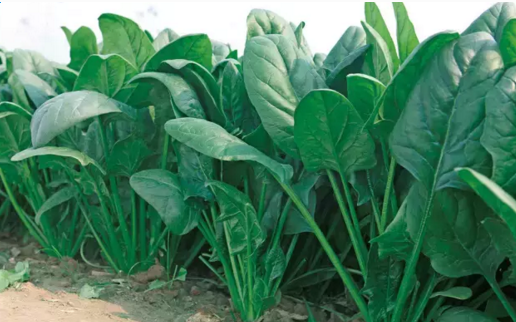The root system of spinach is very developed, with a distribution range of up to 1 cubic meter. It is suitable for sandy loam soil rich in organic matter. Neutral soil with pH 6.3-7.0 is suitable. Acidic pH less than 5.5 will affect germination and even death. Spinach is a wet crop and soil moisture exceeds More than 20% will produce wet roots and death. The requirement for water in a lifetime is that the initial water needs less water, promotes root development, and absorbs water in the soil.
Therefore, before planting, watering should be adequately ensured to ensure that the seedlings and seedlings are no longer watered and germinated to the 3-4 leaf stage. In order to prevent the occurrence of blight, it is necessary to control the watering. The amount of water needed in the middle and late stages of growth is increased. It is generally necessary to water 3-5 times to keep the soil moist. The wintering spinach is poured into the “frozen water†before winter. When the temperature is high in summer, water should be watered in the morning or evening to promote growth by cooling; water should be poured in time after fertilization. Before harvesting, watering should be stopped to ensure quality, and the disease caused by excessive humidity can be alleviated.

The fertilization of spinach is divided into base fertilizer and top dressing.
1 base fertilizer
Spring spinach is sowed early, can be fertilized in the whole year, 4,000-5000 kg per 667 square meters of fertilized organic fertilizer, 20-25 cm deep, 耙 flat to do 畦, when the early spring soil is frozen 7-10 cm deep can be sown . It is advisable to choose neutral mucoid soil, and it can be applied as a base fertilizer by using a mixture of compost and fertilizer. Composting 3000-4000 kg per 667 square meters, 30-35 kg of superphosphate, 20-25 kg of ammonium sulfate, 10-15 kg of potassium sulfate, 20-25 cm deep, and sputum. Autumn spinach applies 4000-5000 kg of organic fertilizer per 667 square meters, 25-30 kg of superphosphate, 20-25 cm deep, and is made of sorghum or sorghum. Overwintering spinach chooses soil with deep soil layer, fertile soil, high humus content, good fertilizer and water storage capacity, and should apply more organic fertilizer than other seasons. It can apply 5,000 kg of decomposed organic fertilizer per 667 square meters. -30 kg, 20-25 cm deep, so that the soil and fertilizer are fully mixed, loose soil, promote seedling emergence and root development. It is high in the south and Yiping in the north.
2 top dressing
In the early stage of growth, spring spinach generally does not need to fertilize water to facilitate the absorption of nutrients in the soil. In the middle and late stages of fertility, the amount of absorbed fertilizer will increase, and every 667 square meters can be applied with 15-20 kg of ammonium sulfate. Due to the short growth period of spring spinach, sufficient nitrogen fertilizer can make the leaves grow vigorously and delay the convulsion period. Summer spinach is being sown in the hot season. After 2-3 true leaves appear, chasing 1-2 times of available nitrogen fertilizer, 10-15 kg of ammonium sulfate per 667 square meters, and timely watering after fertilization. Additional nitrogen fertilizer can also be applied by 0.3% urea foliar application. After the autumn spinach seedlings are unearthed, when they grow to 4-5 true leaves, they should be applied 2-3 times of quick-acting nitrogen fertilizer in stages. Each 667 square meters of water is applied with 20-25 kg of ammonium sulfate or 10-12 kg of urea to promote thickening of the leaves, increase production and improve quality. Wintering spinach should be fertilized due to its long growth period, which can be divided into three stages: winter, winter and early spring. Before the winter, the growth period is about 50-60 days, combined with irrigation and chasing 1 time fertilizer, 10-15 kg of ammonium sulfate per 667 square meters of water. When pouring "frozen water", apply 1000-1500 kg of diluted manure water. Do not need topdressing to stop the growing season in winter. In the early spring, the growth period is 30-40 days. When the spinach leaves are green, the heart leaves begin to grow, and the small water can be poured once. After the spinach enters the vigorous growth period, it should be topdressed in time, combined with 10-15 kg of ammonium sulfate per 667 square meters of watering. In this period, sufficient fertilizer and water supply can be provided, which can delay convulsions, increase production and improve quality.
Dehydrated carrot granules refer to dried products that try to preserve the original flavor of carrots except for a certain amount of water. The function of dehydration is to reduce the water in carrots, increase the concentration of soluble substances, and inhibit the activity of microorganisms. At the same time, the activity of enzymes contained in carrots is also inhibited, and the products can be stored for a long time. It can often be seen in instant noodle seasoning packets.
Dehydrated Carrot,Pure Natural Carrot,Organic Dehydrated Carrot,Homemade Dehydrated Carrot
Laian Xinshuyu Food Co., Ltd , https://www.xinshuyufood.com